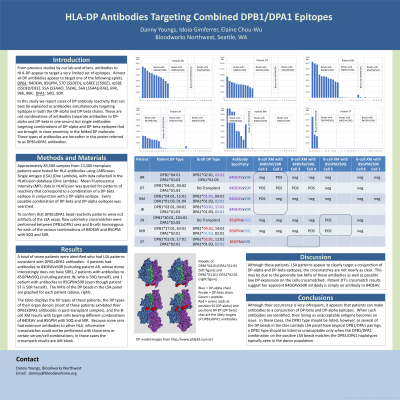Back

HLA-DP Antibodies Targeting Combined DPB1/DPA1 Epitopes
(P413) HLA-DP antibodies targeting combined DPB1/DPA1 epitopes
Location: Platinum Ballroom

Poster Presenter(s)
Body: A transplant candidate screened for HLA antibodies by the LABScreen Single Antigen (LSA) kit was seen to have positive results with DPB1 antigens bearing the 84DEAV epitope but only when DPA1*02 was also present. 84DEAV-bearing antigens with DPA1*01 were negative, as were 85GPM-bearing antigens with DPA1*02. This patient had many samples that displayed this pattern of reactivity, hereafter referred to as 84DEAVx50R (50R being the antibody-verified eplet found in DPA1*02 and DPA1*04).
A comprehensive search of class II LSA data in our HLAFusion database (85,500 samples from 13,500 patients, including 2300 patients with DP reactivity) was performed to identify other sera potentially targeting DPB1/DPA1 combined epitopes. Four patients were identified who had antibodies whose patterns appeared to target 84DEAVx50R. Two patients had antibodies positive with 85GPMx50Q (50Q is found in DPA1*01 and DPA1*03), and one patient had antibodies positive with 85GPMx50R. Several other patients were seen to have antibodies that were positive with all 84DEAV antigens or all 85GPM antigens, but with substantially different MFI levels depending on the DPA1 epitope present. No sera appeared to target any other combination of DPB1-epitopes with DPA1-epitopes.
In the folded DPB1/DPA1 molecule DPB1 eplets 84DEAV/85GPM and DPA1 eplets 50Q/50R are brought fairly near each other, close enough for both to interact with the paratope, such that the affinity of an antibody targeting a DPB1 aa84-87 epitope could be affected by an aa50 epitope on DPA1. The effect of aa50 differences on affinity in this situation may manifest quantiatively as significantly different but still positive MFI levels (a similar observation was reported for strength of cytotoxity recations with DP monoclonal antibodies in the 10th IHWS), or as absolute qualitative differences as seen in several of our patients.
Conclusion: Although infrequent ( <1% of our patients with DP antibodies), patients can make antibodies to combined DPB1/DPA1 epitopes, in particular to the DPB1/DPA1 epitopes we have designated 84DEAVx50Q, 84DEAVx50R, 85GPMx50Q, and 85GPMx50R. In assigning unacceptable antigens for a patient, this should have minimal effect except for those cases in which the DPB1/DPA1 combination in the LSA panel is inconsistent with the DPB1/DPA1 haplotypes typically seen in donors. The most commonly used LSA kit has many examples of unusual DPB1/DPA1 combinations.
A comprehensive search of class II LSA data in our HLAFusion database (85,500 samples from 13,500 patients, including 2300 patients with DP reactivity) was performed to identify other sera potentially targeting DPB1/DPA1 combined epitopes. Four patients were identified who had antibodies whose patterns appeared to target 84DEAVx50R. Two patients had antibodies positive with 85GPMx50Q (50Q is found in DPA1*01 and DPA1*03), and one patient had antibodies positive with 85GPMx50R. Several other patients were seen to have antibodies that were positive with all 84DEAV antigens or all 85GPM antigens, but with substantially different MFI levels depending on the DPA1 epitope present. No sera appeared to target any other combination of DPB1-epitopes with DPA1-epitopes.
In the folded DPB1/DPA1 molecule DPB1 eplets 84DEAV/85GPM and DPA1 eplets 50Q/50R are brought fairly near each other, close enough for both to interact with the paratope, such that the affinity of an antibody targeting a DPB1 aa84-87 epitope could be affected by an aa50 epitope on DPA1. The effect of aa50 differences on affinity in this situation may manifest quantiatively as significantly different but still positive MFI levels (a similar observation was reported for strength of cytotoxity recations with DP monoclonal antibodies in the 10th IHWS), or as absolute qualitative differences as seen in several of our patients.
Conclusion: Although infrequent ( <1% of our patients with DP antibodies), patients can make antibodies to combined DPB1/DPA1 epitopes, in particular to the DPB1/DPA1 epitopes we have designated 84DEAVx50Q, 84DEAVx50R, 85GPMx50Q, and 85GPMx50R. In assigning unacceptable antigens for a patient, this should have minimal effect except for those cases in which the DPB1/DPA1 combination in the LSA panel is inconsistent with the DPB1/DPA1 haplotypes typically seen in donors. The most commonly used LSA kit has many examples of unusual DPB1/DPA1 combinations.

